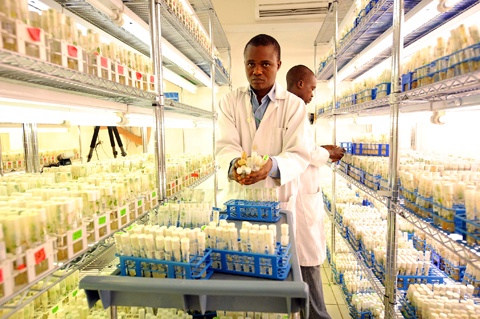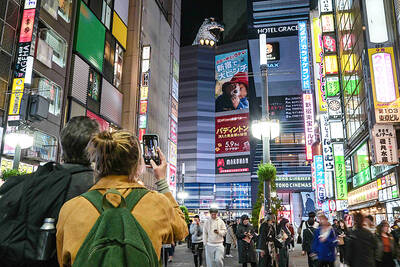The “magic” cassava roots the Nigerian farmer pointed to might have made Charles Darwin smile — and they may also turn out to be part of the solution to hunger across swathes of Africa.
“If you uproot it, you can see six or seven tubers,” said Bashir Adeyinka Adesiyan, a farmer from southwestern Nigeria, the world’s largest producer of cassava. “The one we were planting before, you would only get two or three.”
He called it a “magic plant.”

PHOTO: AFP
Scientists in Nigeria and six other African nations are experimenting with a fast-yielding, disease-resistant species of cassava, a root useful in so many ways that Darwin, the father of evolution theory, once marveled at its diversity.
Workers have to frighten off porcupines seeking to feast on the chubby new cassava stems on Adesiyan’s farm, where a crooked path divides the old species from the new, grown side by side to be able to compare them.
The results so far are glowing: The new plants stand taller and appear stronger and more vibrant. When their tubers are pulled from the ground, they resemble fat, oversized fingers.
The cassava stems are not genetically modified. They were obtained through a conventional process of breeding and selection over more than a decade.
Researchers at the International Institute of Tropical Agriculture (IITA) are distributing the stems to local farmers free of charge.
They hope to get the improved cassava into 75,000 farms by the end of this year to increase yields in seven selected Nigerian states.
It was a carnival-like scene recently in the farming town of Ifon in southwestern Nigeria as officials distributed 1,500 packs of the new cassava stems, with traditional Yoruba drumming and dancing.
Bintu Aderemi, a 55-year-old woman cassava farmer, said the stems “are God-sent. They thrive well and I am very happy.”
Developed in response to the 2008 global food crisis, the project is first aimed at tackling hunger in Africa — particularly in drought-hit Chad and Niger.
However, the versatile cassava plant — which has a wide range of industrial uses — could also one day provide a much-needed raw material to meet China’s growing needs, becoming a potentially lucrative export crop for Africa. The first results have been promising, scientists and farmers say.
Financed by US Agency for International Development, the project targets about 400,000 farmers directly in seven African nations: Sierra Leone, Ghana, Tanzania, Malawi, the Democratic Republic of the Congo, Mozambique and Nigeria, IITA officials said.
“We want to double their yields,” IITA’s Nigeria coordinator Richardson Okechukwu said.
The US$5.3 million project in Africa “will ensure food security for Nigerians and neighboring northern countries like Niger and Chad, and will also provide more roots for large-scale cassava industries,” he said.
Cassava is one of the world’s largest sources of carbohydrates and is eaten in various forms in a long list of countries. In Nigeria, it is ground up for traditional dishes, such as garri and fufu, which are types of porridge served with soup.
In some African countries, including Nigeria, Liberia, Sierra Leone and the Democratic Republic of the Congo, cassava leaves are also consumed for their protein, Okechukwu said.
Long-term, African farmers also stand to make a potential profit from the new strain of cassava, whose industrial uses include the manufacture of tires, adhesives, ethanol, pharmaceuticals, biofuels and livestock feeds.
“China could buy almost everything we produce. That is in the future,” IITA director-general Peter Hartmann said.
The crop could be an opportunity for farmers in Nigeria, where agriculture has played a diminished role in the economy dominated by oil.
Though Nigeria leads the world in cassava production — 44.6 million tonnes in 2008, according to the UN Food and Agriculture Organization — it is mainly for domestic consumption. Thailand is the world’s largest exporter of cassava.
“We know that with climate change and the increased drought, definitely there is going to be more and more demand,” Hartmann said.

POLITICAL PRISONERS VS DEPORTEES: Venezuela’s prosecutor’s office slammed the call by El Salvador’s leader, accusing him of crimes against humanity Salvadoran President Nayib Bukele on Sunday proposed carrying out a prisoner swap with Venezuela, suggesting he would exchange Venezuelan deportees from the US his government has kept imprisoned for what he called “political prisoners” in Venezuela. In a post on X, directed at Venezuelan President Nicolas Maduro, Bukele listed off a number of family members of high-level opposition figures in Venezuela, journalists and activists detained during the South American government’s electoral crackdown last year. “The only reason they are imprisoned is for having opposed you and your electoral fraud,” he wrote to Maduro. “However, I want to propose a humanitarian agreement that

ECONOMIC WORRIES: The ruling PAP faces voters amid concerns that the city-state faces the possibility of a recession and job losses amid Washington’s tariffs Singapore yesterday finalized contestants for its general election on Saturday next week, with the ruling People’s Action Party (PAP) fielding 32 new candidates in the biggest refresh of the party that has ruled the city-state since independence in 1965. The move follows a pledge by Singaporean Prime Minister Lawrence Wong (黃循財), who took office last year and assumed the PAP leadership, to “bring in new blood, new ideas and new energy” to steer the country of 6 million people. His latest shake-up beats that of predecessors Lee Hsien Loong (李顯龍) and Goh Chok Tong (吳作棟), who replaced 24 and 11 politicians respectively

Young women standing idly around a park in Tokyo’s west suggest that a giant statue of Godzilla is not the only attraction for a record number of foreign tourists. Their faces lit by the cold glow of their phones, the women lining Okubo Park are evidence that sex tourism has developed as a dark flipside to the bustling Kabukicho nightlife district. Increasing numbers of foreign men are flocking to the area after seeing videos on social media. One of the women said that the area near Kabukicho, where Godzilla rumbles and belches smoke atop a cinema, has become a “real

‘WATER WARFARE’: A Pakistani official called India’s suspension of a 65-year-old treaty on the sharing of waters from the Indus River ‘a cowardly, illegal move’ Pakistan yesterday canceled visas for Indian nationals, closed its airspace for all Indian-owned or operated airlines, and suspended all trade with India, including to and from any third country. The retaliatory measures follow India’s decision to suspend visas for Pakistani nationals in the aftermath of a deadly attack by shooters in Kashmir that killed 26 people, mostly tourists. The rare attack on civilians shocked and outraged India and prompted calls for action against their country’s archenemy, Pakistan. New Delhi did not publicly produce evidence connecting the attack to its neighbor, but said it had “cross-border” links to Pakistan. Pakistan denied any connection to